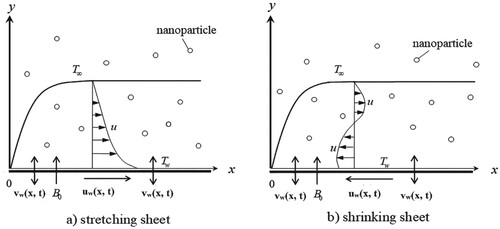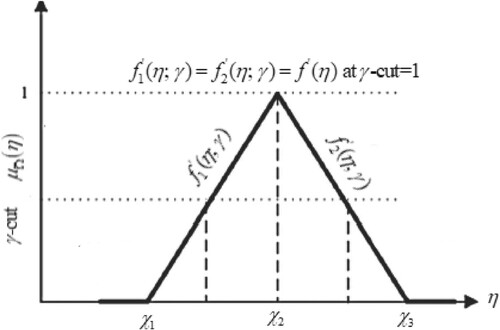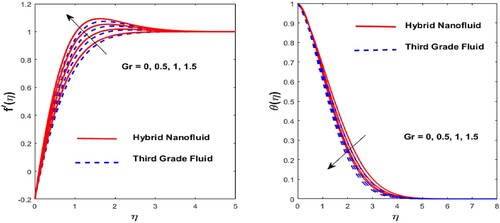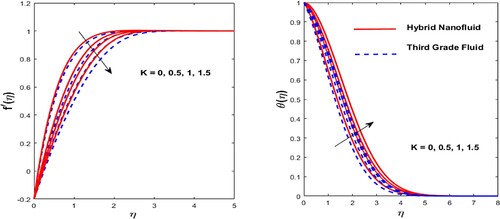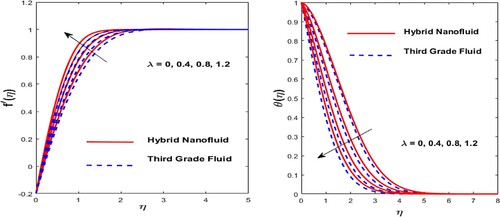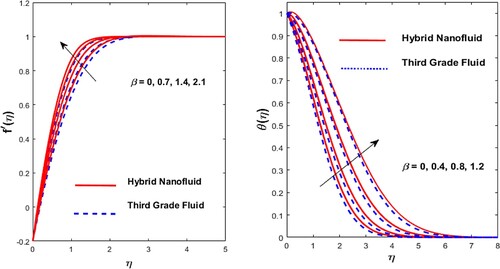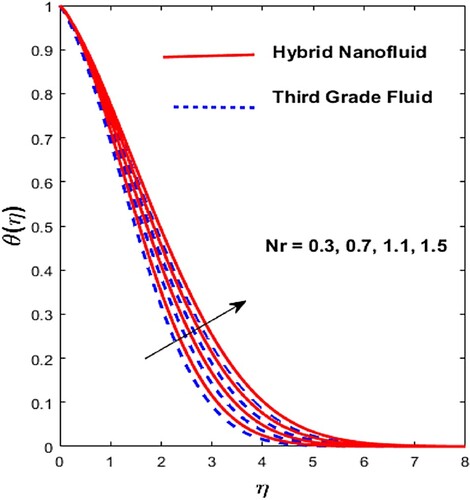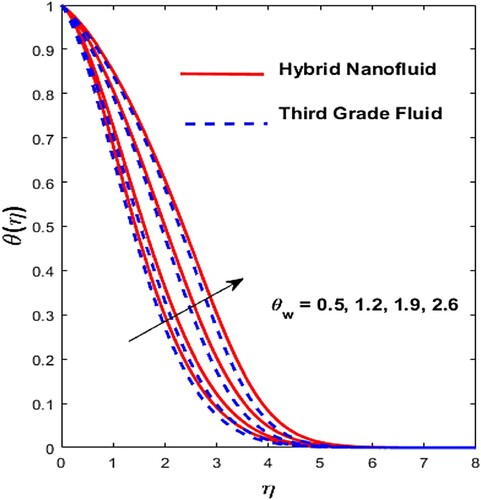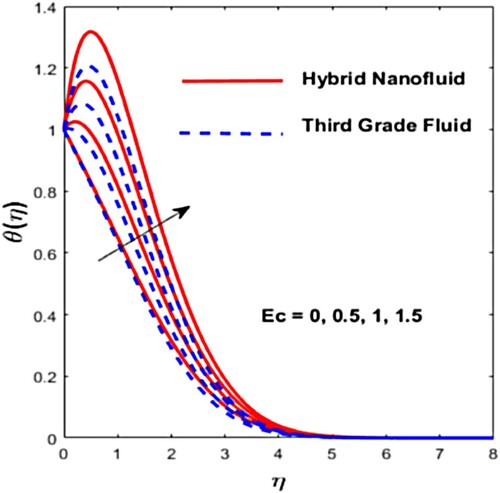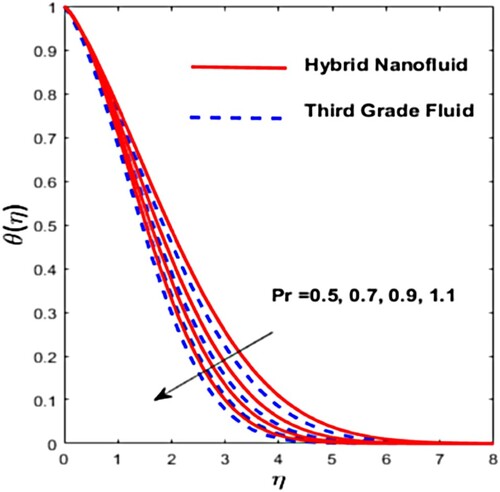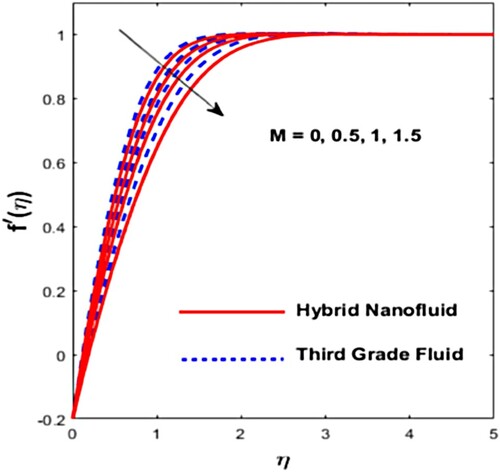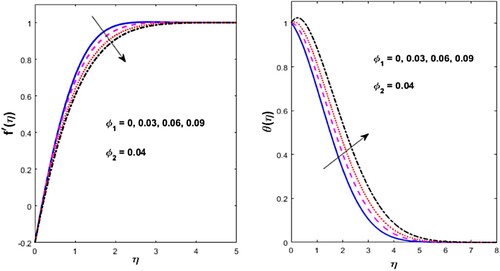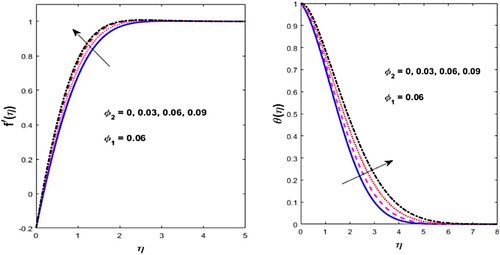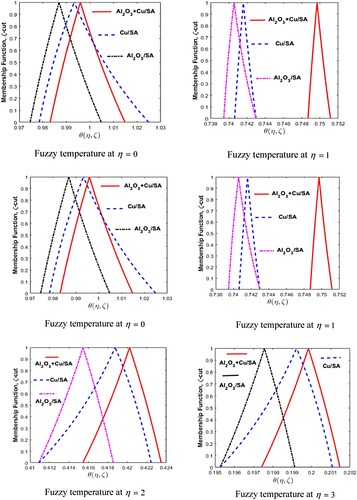 ?Mathematical formulae have been encoded as MathML and are displayed in this HTML version using MathJax in order to improve their display. Uncheck the box to turn MathJax off. This feature requires Javascript. Click on a formula to zoom.
?Mathematical formulae have been encoded as MathML and are displayed in this HTML version using MathJax in order to improve their display. Uncheck the box to turn MathJax off. This feature requires Javascript. Click on a formula to zoom.Abstract
In current work, the unsteady stagnation point’s flow on a special third-grade fuzzy hybrid nanofluid (HNF) through a permeable convective shrinking/stretching sheet has been scrutinized. In addition, the adverse consequences of heat source, viscous dissipation, nonlinear thermal radiation, and fuzzy nanoparticle volume fraction are likewise taken into consideration. Non-linear coupled partial differential equations (PDEs) get transformed into ordinary differential equations (ODEs) using an effective similarity transformation. After that, the ODEs are numerically solved using the bvp4c algorithm. Regarding validation, the present results align with earlier published research. The effects of heat distribution, flow rate, Nusselt number, and skin friction coefficient on hybrid nanofluid dynamics are explored using graphical and tabular forms. The nanoparticle volume fraction is considered a triangular fuzzy number (TFN) [0, 5%, 10%]. With the use of TFNs, ODEs are transformed into fuzzy differential equations (FDEs). The TFNs are controlled using a widely used
technique and
which requires minimal computational effort to examine their dynamical performance. Also, the comparison of
and
through the fuzzy membership functions (MFs). The fuzzy MFs show that the hybrid nanofluid (
) in terms of rate of heat transfer is better than both
and
nanofluids.
Nomenclature
| = | Cartesian coordinates | |
| = | Velocity components | |
| = | Uniform Magnetic field | |
| = | Temperature | |
| = | Reference and ambient temperature | |
| = | Heat absorption/ generation coefficient | |
| = | Radiatively heat source | |
| = | HNF density | |
| = | Density of fluid | |
| = | HNF dynamic viscosity | |
| = | Fluid Dynamic viscosity | |
| = | Fluid Electrical conductivity | |
| = | Similarity variable | |
| = | HNF thermal-expansion coefficient | |
| = | Dimensionless heat source | |
| = | Thermal radiation parameter | |
| = | Rate of mass transfer parameter | |
| = | Normal component of the flow | |
| = | Dimensionless temperature | |
| K | = | Third-grade fluid parameter |
| = | Local Reynold number | |
| = | HNF heat capacity | |
| = | Solid nanoparticles of | |
| Pr | = | Prandtl number |
| = | Stream function | |
| = | Eckert number | |
| = | Temperature ratio parameter | |
| = | Magnetic parameter | |
| = | Shrinking/stretching rate parameter | |
| = | Unsteady parameter | |
| = | Grashof number | |
| = | Electrical conductivity of HNF | |
| = | cut technique | |
| = | Membership function (MF) | |
| = | Fuzzy velocity | |
| = | Fuzzy temperature | |
| = | The volume fraction of copper | |
| = | Volume fraction of alumina | |
| = | Fluid kinematic-viscosity | |
| = | Fluid thermal conductivity | |
| = | HNF thermal conductivity | |
| = | Nusselt numberi | |
| = | Skin-friction coefficient | |
| = | Fluid heat capacity |
1. Introduction
Non-Newtonian fluids (NNFs) have played a dominant position in engineering and industrial processes in recent years due to their wide uses. Here, clay coatings, blood, saliva, polymer solutions, certain oils, paints, molten plastics, ketchup, artificial fibers, and lubricants are some instances of NNFs. As dynamic elastic characteristics, these liquids do not obey the well-known Newton's law of viscosity. Some liquids are enormously viscous which does interpret their significant properties of elasticity such as boiling, polymer depolarization, bubble absorption, composite processing, etc. There are three foremost classes of NNFs such as integral type, rate type, and differential type. Third-grade fluid is a well-known subclass of the differential type fluid that displays the normal stress effect but does not show shear thickening or thinning phenomena (Fosdick & Rajagopal, Citation1979). On the other way, the third-grade-fluid model can visualize both the normal stresses along shear-thinning or thickening phenomena even though the basic equations have numerous complexities (Dunn & Rajagopal, Citation1995; Pakdemirli, Citation1994). Various scholars have investigated the flows of a third-grade fluid model from different perspectives such as Keçebas and Yürüsoy (Keçeba & Yürüsoy, Citation2006) studied the unsteady flow of special third-grade fluid and calculated the solution using the shooting technique. Ellahi and Riaz (Ellahi & Riaz, Citation2010) examined the flow of a third-grade fluid using magneto-hydro-dynamic (MHD) and erratic viscosity through a pipe with the analytical technique homotopy analysis method (HAM). Sahoo and Do (Sahoo & Do, Citation2010) examined the effect of slip and magnetic effect of a third-grade fluid via a stretched surface. Later on, Sahoo and Poncet (Sahoo & Poncet, Citation2011) inspected the slip effect on a third-grade fluid through an exponentially stretched moving sheet. The unsteady flow of a particular third-grade fluid across a moving permeable surface was investigated by Abbasbandy and Hayat (Abbasbandy & Hayat, Citation2011). Naganthran et al. (Naganthran et al., Citation2016) inspected the double solution of unsteady flow of a special type of third-grade liquid over a porous shrinking/stretched sheet. Reddy et al. (Reddy et al., Citation2018) scrutinized the unsteady flow of a third-grade fluid over a cylinder. Also, they determined that the NNF has a substantial impact as compared to NF. Zaib et al. (Zaib et al., Citation2017; Zaib et al., Citation2020) examined the convective and nonlinear thermal radiation effect on a special third-grade fluid through a permeable shrinking surface. Several scholars have examined this model's flows from a variety of aspects (Bhattacharyya, Citation2011; Kumar et al., Citation2019; Mahmood et al., Citation2024).
The energy moving from one place to another in the waveform is called thermal radiation. The waves of radiation are moving in all directions. Nonlinear radiation is greatly appreciated in modern science and advanced technologies because its effects and intensity help in the construction of nano-scale devices. Due to their small sizes, nanosized particles in nanofluid absorb a large amount of nonlinear radiative radiation. Consequently, nanoparticles magnify the radiative features of fluids, causing to increase in sufficient absorption of solar collectors. Numerous scholars (Moayedi et al., Citation2024; Nadeem et al., Citation2023c; Nasir & Berrouk, Citation2023; Siddique et al., Citation2023; Zulqarnain et al., Citation2023c) are attracted to studying the impact of quadratic thermal radiation.
The MHD is an electrically conductive field, which itself adjusts the magnetic field and creates a current that constructs forces to control the boundary layer flow (BLF). The magnetic field provides a drag force which is named the Lorentz force in a flowing liquid, which holds the fluid flow and therefore raises the fluid temperature. Consequently, MHD has a great reputation in production and manufacturing progressions, such as stretching of plastic sheets, metal casting, plasma studies, turbulent pumps, geothermal energy extractions, optical grafting, MHD generators, metallurgical process, nuclear reactor safety, polymer industry, and furnace structure (Jawad et al., Citation2021; Krishna et al., Citation2019b; Krishna & Chamkha, Citation2019a; Nadeem et al., Citation2021b; Siddique et al., Citation2021; Waini et al., Citation2021).
Classical fluids such as engine oils, ethylene glycol, and water have lower thermal performance that restricts their usage in advanced cooling applications. The nanofluids (NFs) (Choi & Eastman, Citation1995; Huminic & Huminic, Citation2018; Shah & Ali, Citation2019; Xian et al., Citation2018) are a great invention that effort to raise the heat transmission rate and thermal conductivity. The size of nanoparticles consists of (1-100 nm) in the base fluids. There are different nanoparticles used in the base fluids such as carbides, copper, nitrides, carbon nanotubes metals, alumina, graphite, and metal oxides that enhance the host fluid's thermal conductivity. Mostly NFs are frequently used in solar panels, hybrid-powered vehicles, the latest fuel generation, medicine, cancer treatment, drug delivery, and modern heating, and cooling systems.
HNFs consist of two solid nanosized particles such as
etc. in base fluids (sodium alginate, kerosene, water, engine oil or ethylene glycol). The prime goal of HNFs is to maximize heat transmission and thermal expansion. HNFs are now used in several heat transmission applications such as air conditioning systems, microchannels, mini channel heat sinks, tubular, plate heat exchangers, and helical coil heat exchangers. The literature review reveals a thorough examination of HNFs such as Roy and Pop (Roy & Pop, Citation2020) examined the upshot of MHD second-grade
HNF flow through a permeable shrinking/stretching surface. Devi and Devi (Devi & Devi, Citation2016; Devi & Devi, Citation2017) studied the heat transfer with mathematical analysis of
through a shrinking/stretching surface. The impact of heat generation and MHD flow of HNFs flowing over a rotating channel was inspected by Chamkha et al. (Chamkha et al., Citation2019). Hussanan et al. (Hussanan et al., Citation2020) considered the heat improvement properties of NNF
HNF flow through a shrinking/stretching sheet. The behaviors of
HNF past a stretching sheet were deliberated by Subhani and Nadeem (Manjunatha et al., Citation2022). Nadeem et al. (Manjunatha et al., Citation2019) analyzed the theoretic investigation of the
HNF through an exponentially curved stretching sheet. Jawad et al. (Nasir et al., Citation2024) scrutinized the impression of MHD flow and thermal radiation on HNF (
) second-grade nanofluid over a non-linear stretching/shrinking sheet. The heat transfer of
HNF through a stretching sheet was curious by Yahaya et al. (Krishna et al., Citation2021). Numerous theoretical and experimental studies have been reported on different HNFs in the modern literature, e.g. (Nadeem et al., Citation2021a; Nadeem et al., Citation2022; Nadeem et al., Citation2023a; Nadeem et al., Citation2023b; Zulqarnain et al., Citation2023a; Zulqarnain et al., Citation2023b).
The relevant variables and parameters are intended to be precise or well-defined in the prevalent research of physical systems expressed through FDEs. However, as errors in experiments and observations are possible, these values may be regarded as ambiguous and unclear. As a result, the majority of physical systems lack sufficient knowledge of the relevant parameters and variables, which could cause uncertainty (Priyadarshini & Nayak, Citation2023; Yang et al., Citation2024). Regarding, the fuzzy theory and FDE approaches are presented here as well as the uncertain circumstance in particular. To address the uncertainty brought on by inadequate information that arises in several mathematical models of various real-world processes, FDEs fuzzy analysis has recently been presented. There are thus a few contributions here that deal with fuzzy theory and modeling. The outcomes of a stretched surface on an MHD tangent Casson fuzzy HNF were inspected by Shanmugapriya et al. (Shanmugapriya et al., Citation2024). By using a fuzzy membership function, they identify that HNFs have superior heat transmission than nanofluids. The influence of Cross HNF tiny liquids across a vertical duct with a fuzzy volume percentage was scrutinized by Ayub et al. (Ayub et al., Citation2024).
Unsteady, heat transfer, and stagnation-point flow of a special third-grade fuzzy HNF through a permeable convective shrinking/stretching surface under the outcome of the nonlinear thermal radiation, viscous dissipation, and heat source/sink have not yet been examined in the literature. The significant numerical technique bvp4c (finite difference technique) is employed to solve dimensionless coupled highly non-linear ODEs. The impacts of the nanoparticle's volume fraction and physical parameters on the velocity and temperature fields are elaborated graphically. In addition, this work compares nanofluid with hybrid nanofluid via a triangle membership function. The proposed problem is modified into fuzzy differential equations and then again applied to the numerical scheme bvp4c. A triangular fuzzy number is used to describe the volume percentage of nanoparticles. The
technique is used to handle the triangular fuzzy number.
2. Problem formulation
The 2D unsteady MHD, nonlinear radiation, and stagnation-point flow induced by permeable shrinking/stretching sheet of a third-grade HNF are examined in this investigation. The x-axis of the Cartesian coordinates is parallel to the sheet, and the y-axis is normally to the sheet as shown in Figure . The sheet begins to move at time t = 0 with the velocity
where
is a non-dimensional constant, through
representing a stretched sheet and
indicating a shrinking sheet, respectively. An external free stream velocity is
The velocity of the shrinking/stretching sheet is
with b > 0 and c showing the unsteadiness. Further Tw > T∞ (heated sheet), Tw is the uniform temperature, T∞ is the ambient temperature, and
is the mass flux velocity of the sheet.
The foremost equations of the time-dependent flow under investigation as a result of these assumptions are as follows (Dunn & Rajagopal, Citation1995; Nadeem et al., Citation2021b; Naganthran et al., Citation2016; Pakdemirli, Citation1994; Zaib et al., Citation2017; Zaib et al., Citation2020):
(1)
(1)
(2)
(2)
(3)
(3)
the boundary conditions are:
(4)
(4) here the free-stream velocity is
with
as a constant and
is the magnetic field externally imposed in the y-direction. It should also be observed that
simplifies the above case to a Newtonian fluid.
The thermophysical properties of are shown in EquationEq. (5
(5)
(5) ) (Krishna et al., Citation2021; Nadeem et al., Citation2023a; Nadeem et al., Citation2023b).
(5)
(5) where
and
are nanoparticles having the volume fractions
and
respectively. Also
and
denote the
and
solid nanoparticles, respectively. The thermophysical properties of Copper
, Sodium Alginate (SA), and Aluminum oxide
are shown in Table .
Table 1. The thermophysical characteristics of , as well as
and SA. (Krishna et al., Citation2021; Nadeem et al., Citation2023a; Nadeem et al., Citation2023b).
Now, for non-dimensionalizing governing equations, we introduce the appropriate similarity variables (Zaib et al., Citation2017; Zaib et al., Citation2020).
(6)
(6) where
similarity variable and
stream function are defined as
(7)
(7) where
is the mass transfer parameter through the permeable sheet, with
< 0 indicating suction and
> 0 indicating injection, and
is the velocity rati o parameter. Here for similarity solution, we assumed that
where
being a constant (Zaib et al., Citation2017; Zaib et al., Citation2020). The following ordinary (similarity) equations can be constructed by substituting (6) into equations (2), (3), and (4), we have.
(8)
(8)
(9)
(9) in addition to the constraints
(10)
(10) The dimensionless parameters are defined as follows:
here β > 0 or β < 0 indicates an accelerating and decelerating flow respectively.
Now we will discuss some significant engineering quantities like the drag force and the heat transfer rate, which are both defined as (Zaib et al., Citation2017; Zaib et al., Citation2020)
(11)
(11) Using EquationEq. (6
(6)
(6) ) in EquationEq. (11
(11)
(11) ), we have,
(12)
(12)
3. Fuzzy formulation
A fuzzy set is defined as
where X is the universal set,
is the MF or grade of membership of
and mapping is defined as a
value of
ranges from 0 to 1. The value
indicates that
is not part of the fuzzy set and if
= 1,
is a member of the fuzzy set. When 0 <
< 1, the MF of
the fuzzy set is imprecise. A set
is called a
of
A crisp set is formed by a bounded
containing
becomes a crisp set and is commonly used in fuzzy structural analysis. TFNs are frequently used in the modeling of fuzzy structural parameters due to their mathematical simplicity.
is a TFN defined entirely by three quantities:
(lower bound),
(most belief value), and
(upper bound) are shown in Figure .
By the TFN, the MF can be expressed as.
TFNs are converted to interval numbers using a technique that is stated as
which is written as
, where
A slight change in the nanoparticle's volume fraction has an impact on temperature and velocity. The flow velocity and heat transfer are entirely dependent on such values, which use a nanoparticle volume in the range of [1% – 4%]. Therefore, ambiguity develops as a result of the static crisp values of nanoparticle volume fractions. The volume fraction of nanoparticles can be treated as TFN due to insufficient information. Because and
indicate the volume fractions of
and
it is easier to deal with a complex problem in a fuzzy atmosphere by treating both
and
as FN. With TFNs being converted into
procedures as shown in Table .
Table 2. TFNs of fuzzy nanoparticles of volume fraction.
TFNs are being used to express triangular MFs, which range from 0 to 1, as can be seen in Figure . For the fuzzy solution, non-linear DEs (7) to (9) can be renovated into FDEs (Priyadarshini & Nayak, Citation2023; Shanmugapriya et al., Citation2024; Yang et al., Citation2024).
(13)
(13)
(14)
(14) in addition to the constraints
(15)
(15) where the fuzzy velocity
and temperature
fields can be written as
and
Here,
is lower bound and
is an upper bound of fuzzy velocity and temperature profiles respectively.
3.1. For validation
The numerical outcomes emitted by the above-described technique are validated via the comparison of with the previously published results of Bhattacharyya (Bhattacharyya, Citation2011) and Naganthran et al. (Naganthran et al., Citation2016) as shown in Table . This suggests that the computational tools used in this study are accurate and dependable because the results of the numerical simulations express a high degree of agreement with the body of existing literature.
Table 3. Comparison of with previously published works when
and
4. Results and discussion
The boundary conditions (10) and the ODEs (8) – (9) are numerically determined using the bvp4c algorithm built-in Matlab program. Different dimensionless parameters with standard values such as
,
and
effect on velocity
and temperature
fields are illustrated in Figures for fluid (Third-grade) and
hybrid nanofluid. Table replicates the performance of numerous parameters as discussed above on Nusselt number as well as skin friction. Also, HNF profiles are shown in all of the figures as red solid lines, whereas the third-grade fluid's profiles are indicated by blue dashed lines.
Figure indicates the impression of buoyancy forces (Gr) on and
for both liquids. Due to the rise in Gr, the
of the fluid and HNF upsurges while the
decreases. Physically, when the buoyancy force works on the shirking sheet then stimulates particles to move toward the sheet; as a result,
enhances, and the
field declines. The upshot of the shear-thinning/thickening parameter (K) on the fluid/HNF
(a) and
(b) have been examined in Figure . The
of the fluid and HNF declined as K is improved due to the thickness of the momentum BL. Therefore, the
of fluid and HNF amplified with an upsurge in K. The influence of the suction parameter
on
and
for both liquids is exposed in Figure . It is detected that when
is amplified the
of hybrid nanofluid grows while a diminish in the
of the fluid and HNF is noted. The rise in flow rate is due to the creation of a vacuum by the suction of fluid and hybrid nanofluid. For decreasing the temperature, the heat is discharged from the sheet due to the fluid moving faster. Figure displays the time-dependent parameter
on
and
for both liquids. It is evident that
upsurges for enlarging
and, consequently, the velocity BL thickness reduces. The influence of
amplifies the speed of liquid flow so, increasing the both fluid velocity. The temperature rises due to an increase in
Physically, with a rise in
the thermal BL thickness upsurges consequently the heat transmission upsurges. Figure demonstrates the impression of thermal radiation (Nr) on
for both liquids. It is apparent that when Nr is augmented, the temperature rises so the thermal BL is enhanced as the surface temperature grows. Physically, radiation improves the Brownian motion of tiny particles so they hit each other and induced frictional energy changes into thermal energy. Also, the temperature of regular fluids is lower than HNFs.
Figure describes the outcome of the temperature ratio parameter on the
for both liquids. It is observed that the temperature of fluids enhance with an upsurge of
Physically when increasing
the strength of non-linear thermal radiation will magnify so, the temperature of both fluids increases. HNFs acquire higher temperatures than regular fluids. The thermodynamical variation of the Eckert number (Ec) observed in
is designated in Figure . As can be observed, when Ec is increased,
of both liquids increases. Physically, the Ec indicates the ratio of kinetic energy to enthalpy, and the total work is done against the viscosity and the kinetic energy is changed into internal energy. So, viscous dissipation increases the fluid temperature. The role of Prandtl number (Pr) in
for both fluids is examined in Figure . The upsurge in Pr leads to a decline in the thermal BL, thus dropping the heat flux. The rise in Pr makes the density weaker than kinematic viscosity, which produces resistant strength against the fluid flow. This spectacle makes the fluid and HNF thicker, thus, a failure in the temperature is observed. Figure displays the inspiration of the magnetic parameter (M) on the
for both liquids. It can be seen that the fluid velocity falls with the larger values of M. Physically, the variations in M cause accrue Lorentz forces which reduce the fluid velocity. Figure illustrates the consequence of the heat absorption/generation parameter (H) on
The
upsurges when the (H > 0) rises. Physically, during an rise in heat generation, the convection current decreases the density of the fluid which causes an increase in
The upshot of the nanoparticles volume fraction
on
and
is depicted in Figure . Due to the rise
the
declines, but the temperature profile is found to escalates. As a result, the momentum and thermal BL become thicker for large value of
Physically, the thermophysical characteristics of the HNF are changing due to the presence of
nanoparticles in the liquid, and thus the flow velocity reduces by the viscous force and the heat diffusion increase by larger thermal conductivity. Figure describes the effect of the volume fraction of Cu nanoparticles
on
and
. It is detected that when
is increased, on
and
increase gradually. Physically, the density of HNF falls as
climbs, boosting velocity and temperature. As a consequence, the intermolecular contacts between HNF particles weaken, and the HNFs velocity increases.
This article also covers the triangular MF comparison of
and
Using the
approach
, the volume fraction of nanoparticles
and
is taken to be TFNs (see Table ). FDEs and the
technique are used to convert the fuzzy velocity and temperature equations into lower and upper bounds.
Figure illustrates the MFs of for different values of
to compare the nanofluids
and
HNFs. We examined three possible cases in these figures. Black-dashed lines suggest the case when
is taken as TFN and
. Blue lines represent
which is taken as TFN whereas
. In the third case, red lines expression the
with both
and
non-zero. The
for varying
is presented on the horizontal axis, while the MF of the
for varying
are shown on the vertical axis. It can be realized that when comparing of
and
with
, because of its more noticeable temperature difference than the other two, the HNF performs better. The combined thermal-conductivities of
and
provide the extreme heat transfer. When a evaluation of
and
nanofluids is analyzed,
has a higher heat transfer rate because Cu has a higher thermal-conductivity than
. The
against
is discussed in Figure using the same three scenarios as in Figure . It's also worth noting that the
of
is greater than that of
or
.
Table summarizes the implications of numerical values for a variety of physical parameters on the surface drag and heat transfer rate of a . Surface drag is amplified over the surface with parameters such as magnetic parameter, mass transfer rate, third-grade fluid parameter, heat source,
and
while it is concentrated for the Pr. The upshot of the constraints on
is given in the next column of Table . When the Pr, mass transfer rate, thermal radiation parameter, velocity ratio parameter, temperature ratio parameter, magnetic parameter, heat source parameter,
and
are boosted, the heat transfer rate progresses, however, it lowers for bigger values of the Ec and the third-grade fluid parameter. Additionally, compared to traditional fluids, hybrid nanofluids have a faster heat transmission rate.
Table 4. Numerical values of f ″(0) and θ′(0) for dissimilar values of control constraints.
5. Concluding remarks
In this study, the modeled PDEs are rebuilt into ODEs employing appropriate transformation in terms of momentum and thermal energy. The bvp4c scheme is used to solve the converted ODEs. Graphs show the effects of different physical parameters on momentum as well as the thermal profiles of both (third-grade) and hybrid nanofluid. The Nusselt number and surface drag force for the different values of constraints are provided in tabular form. A triangular fuzzy membership function is used to compare the nanofluid with the hybrid nanofluid for a better understanding and rate of heat transfer. Transformed ODEs are converted into FDEs with the help of TFNs then used numerical scheme bvp4c is used. Several noteworthy discoveries from this investigation are listed below.
declines the flow rate while temperature distribution boosts up. The temperature, velocity distribution, and rate of heat transfer increase as
rising.
When the comparison of
and HNFs is analyzed, it is noticed that the sheet temperature and the heat transference rate of HNFs are noticeably greater.
The higher value of the
causes a rise in the temperature and velocity fields.
The heat transfer rate boosts for the larger values of the temperature ratio, heat source, Eckert number, and nonlinear thermal radiation parameter.
The drag force escalates when the heat source, mass transfer rate,
,
and
growths and it declines when a magnetic parameter and Pr upsurge.
The Nusselt number enhances with growing values of the temperature ratio, magnetic parameter, and thermal radiation while diminishing with rising values of
,
and
Triangle fuzzy MFs demonstrated that
are significantly more effective at increasing the rate of heat transfer than
and
nanofluids. When compared, the
nanofluid performs better than the
nanofluid as well.
Acknowledgements
Open Access funding provided by the Qatar National Library.
Data availability statement
The data used to support the findings of this study are available from the corresponding author upon request.
Disclosure statement
No potential conflict of interest was reported by the author(s).
References
- Abbasbandy, S., & Hayat, T. (2011). On series solution for unsteady boundary layer equations in a special third-grade fluid. Communications in Nonlinear Science and Numerical Simulation, 16(8), 3140–3146. doi:10.1016/j.cnsns.2010.11.018
- Ayub, A., Shah, S. Z. H., Sabir, Z., Rashid, A., & Ali, M. R. (2024). A novel study of the cross nanofluid with the effects of inclined magnetic field in fuzzy environment. International Journal of Thermofluids, 22, 100636. doi:10.1016/j.ijft.2024.100636
- Bhattacharyya, K. (2011). Dual solutions in unsteady stagnation-point flow over a shrinking sheet. Chinese Physics Letters, 28(8), 084702. doi:10.1088/0256-307X/28/8/084702
- Chamkha, A. J., Dogonchi, A. S., & Ganji, D. D. (2019). Magneto-hydrodynamic flow and heat transfer of a hybrid nanofluid in a rotating system among two surfaces in the presence of thermal radiation and joule heating. AIP Advances, 9(2), 025103. doi:10.1063/1.5086247
- Choi, S. U., & Eastman, J. (1995). Enhancing thermal conductivity of fluids with nanoparticles. ASME Publ. Fed, 231, 99–103.
- Devi, S. P. A., & Devi, S. S. U. (2016). Numerical investigation of hydromagnetic hybrid Al2O3+Cu/H2O nanofluid flow over a permeable stretching sheet with suction. International Journal of Nonlinear Sciences and Numerical Simulation, 17(5), 249–257. doi:10.1515/ijnsns-2016-0037
- Devi, S. S. U., & Devi, S. P. A. (2017). Heat transfer enhancement of Al2O3+Cu/H2O hybrid nanofluid flow over a stretching sheet. J Niger Math Soc, 36(2), 419–433.
- Dunn, J. E., & Rajagopal, K. R. (1995). Fluids of differential type: Critical review and thermodynamic analysis. International Journal of Engineering Science, 33(5), 689–729. doi:10.1016/0020-7225(94)00078-X
- Ellahi, R., & Riaz, A. (2010). Analytical solutions for MHD flow in a third-grade fluid with variable viscosity. Mathematical and Computer Modelling, 52(9-10), 1783–1793. doi:10.1016/j.mcm.2010.07.005
- Fosdick, R. L., & Rajagopal, K. R. (1979). Anomalous features in the model of second-order fluids. Archive for Rational Mechanics and Analysis, 70(2), 145–152. doi:10.1007/BF00250351
- Huminic, G., & Huminic, A. (2018). Hybrid nanofluids for heat transfer applications—A state-of-the-art review. International Journal of Heat and Mass Transfer, 125, 82–103. doi:10.1016/j.ijheatmasstransfer.2018.04.059
- Hussanan, A., Qasim, M., & Chen, Z. M. (2020). Heat transfer enhancement in sodium alginate-based magnetic and non-magnetic nanoparticles mixture hybrid nanofluid. Physica A: Statistical Mechanics and its Applications, 550, 123957. doi:10.1016/j.physa.2019.123957
- Jawad, M., Saeed, A., Tassaddiq, A., Khan, A., Gul, T., Kumam, P., & Shah, Z. (2021). Insight into the dynamics of second grade hybrid radiative nanofluid flow within the boundary layer subject to lorentz force. Scientific Reports, 11(1), 4894. doi:10.1038/s41598-021-84144-6
- Keçeba, A., & Yürüsoy, M. (2006). Similarity solutions of unsteady boundary layer equations of a special third-grade fluid. International Journal of Engineering Science, 44(11-12), 721–729. doi:10.1016/j.ijengsci.2006.04.014
- Krishna, M. V., Ahammad, N. A., & Chamkha, A. J. (2021). Radiative MHD flow of casson hybrid nanofluid over an infinite exponentially accelerated vertical porous surface. Case Studies in Thermal Engineering, 27, 101229. doi:10.1016/j.csite.2021.101229
- Krishna, M. V., & Chamkha, A. J. (2019a). Hall effects on MHD squeezing flow of a water-based nanofluid between two parallel disks. Journal of Porous Media, 22(2), doi:10.1615/JPorMedia.2018028721
- Krishna, M. V., Swarnalathamma, B. V., & Chamkha, A. J. (2019b). Investigations of soret, joule and Hall effects on MHD rotating mixed convective flow past an infinite vertical porous plate. Journal of Ocean Engineering and Science, 4(3), 263–275. doi:10.1016/j.joes.2019.05.002
- Kumar, B., Seth, G. S., Nandkeolyar, R., & Chamkha, A. J. (2019). Outlining the impact of induced magnetic field and thermal radiation on magneto-convection flow of dissipative fluid. International Journal of Thermal Sciences, 146, 106101. doi:10.1016/j.ijthermalsci.2019.106101
- Mahmood, Z., Rafique, K., Adnan Khan, U., Muhammad, T., & Hassan, A. M. (2024). MHD unsteady flow of carbon nanotubes over nonlinear radiative surface with anisotropic slip conditions: Computational analysis of irreversibility for yamada-Ota model. Engineering Applications of Computational Fluid Mechanics, 18(1), 2309139. doi:10.1080/19942060.2024.2309139
- Manjunatha, S., Kuttan, B. A., Jayanthi, S., Chamkha, A., & Gireesha, B. J. (2019). Heat transfer enhancement in the boundary layer flow of hybrid nanofluids due to variable viscosity and natural convection. Heliyon, 5(4), e01469. doi:10.1016/j.heliyon.2019.e01469.
- Manjunatha, S., Puneeth, V., Gireesha, B. J., & Chamkha, A. (2022). Theoretical study of convective heat transfer in ternary nanofluid flowing past a stretching sheet. Journal of Applied and Computational Mechanics, 8(4), 1279–1286.
- Moayedi, H., Ahmadi Dehrashid, A., & Nguyen Le, B. (2024). A novel problem-solving method by multi-computational optimisation of artificial neural network for modelling and prediction of the flow erosion processes. Engineering Applications of Computational Fluid Mechanics, 18(1), 2300456. doi:10.1080/19942060.2023.2300456
- Nadeem, M., Elmoasry, A., Siddique, I., Jarad, F., Zulqarnain, R. M., Alebraheem, J., & Elazab, N. S. (2021a). Study of triangular fuzzy hybrid nanofluids on the natural convection flow and heat transfer between Two vertical plates. Computational Intelligence and Neuroscience, 2021(Article ID 3678335), 15.
- Nadeem, M., Siddique, I., Ali, R., Alshammari, N., Jamil, R. N., Hamadneh, N., & Andualem, M. (2022). Study of third-grade fluid under the fuzzy environment with couette and poiseuille flows. Mathematical Problems in Engineering, 19. doi:10.1155/2022/2458253.
- Nadeem, M., Siddique, I., Bilal, M., & Anjum, K. (2023a). Numerical study of MHD prandtl eyring fuzzy hybrid nanofluid flow over a wedge. Numerical Heat Transfer, Part A: Applications, 1–17.
- Nadeem, M., Siddique, I., Jarad, F., & Jamil, R. N. (2021b). Numerical study of MHD third-grade fluid flow through an inclined channel with ohmic heating under fuzzy environment. Mathematical Problems in Engineering, 2021(Article ID 9137479), 17. doi:10.1155/2021/9137479
- Nadeem, M., Siddique, I., Riaz, Z., Makhdoum, B. M., Zulqarnain, R. M., & Sallah, M. (2023b). Numerical study of unsteady tangent hyperbolic fuzzy hybrid nanofluid over an exponentially stretching surface. Scientific Reports, 13(1), 15551. doi:10.1038/s41598-023-32374-1
- Nadeem, M., Siddique, I., Saif Ud Din, I., Awwad, F. A., Ismail, E. A., & Ahmad, H. (2023c). Impact of chemical reaction on eyring–powell fluid flow over a thin needle with nonlinear thermal radiation. Scientific Reports, 13(1), 21401. doi:10.1038/s41598-023-48400-1
- Naganthran, K., Nazar, R., & Pop, I. (2016). Unsteady stagnation-point flow and heat transfer of a special third-grade fluid past a permeable stretching/shrinking sheet. Scientific Reports, 6(1), 24632. doi:10.1038/srep24632
- Nasir, S., & Berrouk, A. S. (2023). Numerical and intelligent neuro-computational modelling with Fourier’s energy and fick’s mass flux theory of 3D fluid flow through a stretchable surface. Engineering Applications of Computational Fluid Mechanics, 17(1), 2270675. doi:10.1080/19942060.2023.2270675
- Nasir, S., Berrouk, A. S., & Gul, T. (2024). Analysis of chemical reactive nanofluid flow on stretching surface using numerical soft computing approach for thermal enhancement. Engineering Applications of Computational Fluid Mechanics, 18(1), 2340609. doi:10.1080/19942060.2024.2340609
- Pakdemirli, M. (1994). Conventional and multiple deck boundary layer approach to second and third-grade fluid. International Journal of Engineering Science, 32(1), 141–154. doi:10.1016/0020-7225(94)90156-2
- Priyadarshini, S., & Nayak, S. (2023). A new hybrid approach to study heat and mass transfer in porous medium influenced by imprecisely defined parameters. Case Studies in Thermal Engineering, 51, 103619. doi:10.1016/j.csite.2023.103619
- Reddy, G. J., Hiremath, A., & Kumar, M. (2018). Computational modelling of unsteady third-grade fluid flow over a vertical cylinder: A study of heat transfer visualization. Results in Physics, 8, 671–682. doi:10.1016/j.rinp.2017.12.054
- Roy, N. C., & Pop, I. (2020). Flow and heat transfer of a second-grade hybrid nanofluid over a permeable stretching/shrinking sheet. The European Physical Journal Plus, 135(768).
- Sahoo, B., & Do, Y. (2010). Effects of slip-on sheet-driven flow and heat transfer of a third-grade fluid past a stretching sheet. International Communications in Heat and Mass Transfer, 37(8), 1064–1071. doi:10.1016/j.icheatmasstransfer.2010.06.018
- Sahoo, B., & Poncet, S. (2011). Flow and heat transfer of a third-grade fluid past an exponentially stretching sheet with partial slip boundary condition. International Journal of Heat and Mass Transfer, 54(23-24), 5010–5019. doi:10.1016/j.ijheatmasstransfer.2011.07.015
- Shah, T. R., & Ali, H. M. (2019). Applications of hybrid nanofluids in solar energy, practical limitations and challenges: A critical review. Solar Energy, 183, 173–203. doi:10.1016/j.solener.2019.03.012
- Shanmugapriya, M., Sundareswaran, R., Krishna, S. G., & Pal, M. (2024). An analysis of effect of higher order endothermic/exothermic chemical reaction on magnetized casson hybrid nanofluid flow using fuzzy triangular number. Engineering Applications of Artificial Intelligence, 133, 108119. doi:10.1016/j.engappai.2024.108119
- Siddique, I., Khan, Y., Nadeem, M., Awrejcewicz, J., & Bilal, M. (2023). Significance of heat transfer for second-grade fuzzy hybrid nanofluid flow over a stretching/shrinking Riga wedge. AIMS Mathematics, 8(1), 295–316. doi:10.3934/math.2023014
- Siddique, I., Zulqarnain, R. M., Nadeem, M., & Jarad, F. (2021). Numerical simulation of MHD couette flow of a fuzzy nanofluid through an inclined channel with thermal radiation effect. Computational Intelligence and Neuroscience, 2021(6608684), 16.
- Waini, I., Ishak, A., & Pop, I. (2021). Hybrid nanofluid flow towards a stagnation point on an exponentially stretching/shrinking vertical sheet with buoyancy effects. International Journal of Numerical Methods for Heat & Fluid Flow, 31(1), 216–235. doi:10.1108/HFF-02-2020-0086
- Xian, H. W., Azwadi, N., Sidik, C., Aid, S. R., Ken, T. L., & Asako, Y. (2018). Review on preparation techniques, properties and performance of hybrid nanofluid in recent engineering applications. Journal of Advanced Research in Fluid Mechanics and Thermal Sciences, 45, 1–13.
- Yang, Y., Wang, H., Hu, Q., Ji, L., He, Z., Shi, W., Song, X., & Zhou, L. (2024). Two-phase flow investigation of sewage pumps with different tip clearance via computational fluid dynamics and multi-factor ANOVA. Engineering Applications of Computational Fluid Mechanics, 18(1), 2322514. doi:10.1080/19942060.2024.2322514
- Zaib, A., Chamkha, A., Rashidi, M. M., & Bhattacharyya, K. (2017). Impact of nanoparticles on the flow of a special non-newtonian third-grade fluid over a porous heated shrinking sheet with nonlinear radiation. Nonlinear Engineering, 7(2), 103–111. doi:10.1515/nleng-2017-0033
- Zaib, A., Khan, U., Khan, I., Sherif, M., Nisar, K. S., & Seikh, A. H. (2020). Impact of nonlinear thermal radiation on the time-dependent flow of Non-newtonian nanoliquid over a permeable shrinking surface. Symmetry, 12(2), 195. doi:10.3390/sym12020195
- Zulqarnain, R. M., Nadeem, M., Siddique, I., Ahmad, H., Askar, S., & Samar, M. (2023a). Heat transfer analysis of Maxwell tri-hybridized nanofluid through Riga wedge with fuzzy volume fraction. Scientific Reports, 13(1), 18238. doi:10.1038/s41598-023-45286-x
- Zulqarnain, R. M., Nadeem, M., Siddique, I., Mansha, A., Ghallab, A. S., & Samar, M. (2023b). Impacts of entropy generation in second-grade fuzzy hybrid nanofluids on exponentially permeable stretching/shrinking surface. Scientific Reports, 13(1), 22132. doi:10.1038/s41598-023-48142-0
- Zulqarnain, R. M., Nadeem, M., Siddique, I., & Samar, M. (2023c). Numerical study of second-grade fuzzy hybrid nanofluid flow over the exponentially permeable stretching/shrinking surface. Frontiers in Physics, 11, 1301453. doi:10.3389/fphy.2023.1301453

